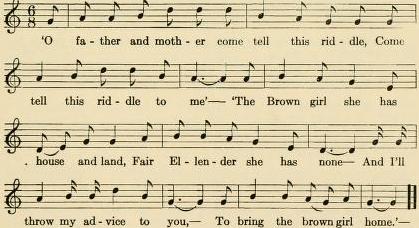Lord Thomas- Cooke (NC) 1922 Brown I
[Fragment with music from the Brown Collection of NC Folklore; Volume 2, 1952. Their notes follow. Music from Brown vol. 4.
R. Matteson 2014]
Lord Thomas and Fair Annet (Child 73)
Of all the old ballads, this probably stands next to 'Barbara Allan' in popular favor. For its range in living tradition, both the old country and in America, see BSM 37-8 and add Tennessee (SFLQ XI 122-3), North Carolina (FSRA 23-4), Florida (SFLQ
VIII 147-50), Arkansas (OFS i 99-101, 106-8), Missouri (OFS 1 94-9, 1 01 -6), Ohio (BSO 29-34), Indiana (BSI 58-70), Illinois (JAFL Lii 75-6), and Michigan (BSSM 37-9). American texts follow one general pattern with various differences in detail — mostly cases of leaving out or putting in. Of the fourteen texts in the Brown Collection only a few are here given in full.
I. 'Lord Thomas.' From the singing of Mrs. Alice Cooke of Boone, Watauga county, in 1922. The text seems somewhat disordered as regards rhythm and rhyme, but perhaps this will be explained in vol. IV, for the text here is taken from the musical score. Lord Thomas "splits his bride in twain" instead of cutting off her head.
"O father and mother come tell me this riddle,
Come tell this riddle to me."
"The brown girl she has house and land,
Fair Ellender she has none,
And I'll throw my advice to you,
To bring the brown girl home."
I. 'Lord Thomas.' Sung by Mrs. Alice Cooke. Recorded at Boone, Watauga county, in 1922. This is a compound of parts of two versions: a variation of the first two lines of stanza 1, version E and a variation of the third stanza of version M. No doubt the original version was in quatrains. The original eight measures, whichever they were, followed this pattern. When the textual corruption took place, enlarging the stanza to six lines, the tune had to be lengthened also. It is easy to see that the first eight measures constitute what we usually consider a normal tune, even if, as in this case, it is a circular tune; and that by omitting measures 7-10 we should have a perfect cadence. But the tune as given here is adapted to the change of text. It should be noted that the first four measures of this version are almost identical with those of the Miller version.

For melodic relationship cf. **BSM 45; TBV 570, No. 18R; FSF 268, No. 1S7B ; and BSSM 37, No. 4.
Scale: Mode III, plagal. Tonal Center: g. Structure: aa1bb1a2c (2,2,2,2,2,2) =abc (4,4,4) ; the c is partially related to a; and b, although considerably altered, is derived from measures 2-3 of a.